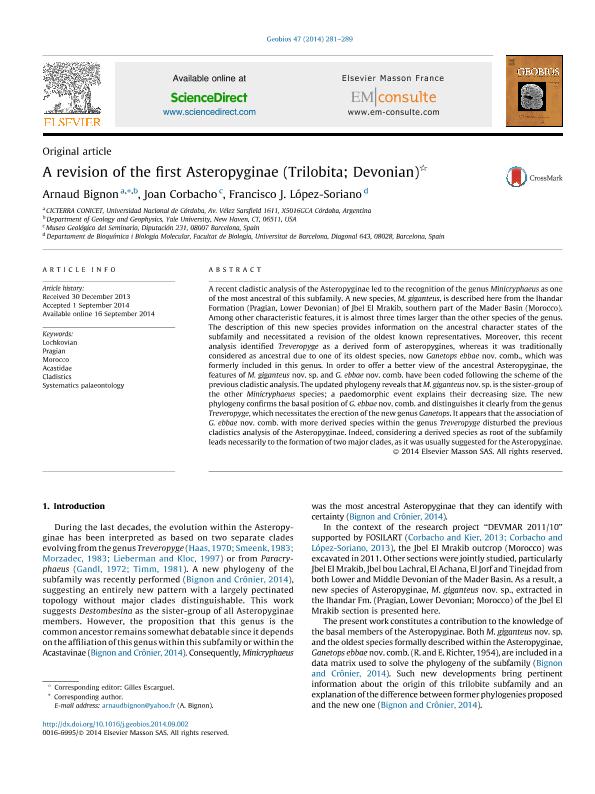Mostrar el registro sencillo del ítem
dc.contributor.author
Bignon, Arnaud Marcel Jacques

dc.contributor.author
Corbacho, Joan
dc.contributor.author
López-Soriano, Francisco J.
dc.date.available
2021-06-15T18:34:48Z
dc.date.issued
2014-09
dc.identifier.citation
Bignon, Arnaud Marcel Jacques; Corbacho, Joan; López-Soriano, Francisco J.; A revision of the first Asteropyginae (Trilobita; Devonian); Elsevier France-editions Scientifiques Medicales Elsevier; Geobios; 47; 5; 9-2014; 281-289
dc.identifier.issn
0016-6995
dc.identifier.uri
http://hdl.handle.net/11336/133928
dc.description.abstract
A recent cladistic analysis of the Asteropyginae led to the recognition of the genus Minicryphaeus as one of the most ancestral of this subfamily. A new species, M.giganteus, is described here from the Ihandar Formation (Pragian, Lower Devonian) of Jbel El Mrakib, southern part of the Mader Basin (Morocco). Among other characteristic features, it is almost three times larger than the other species of the genus. The description of this new species provides information on the ancestral character states of the subfamily and necessitated a revision of the oldest known representatives. Moreover, this recent analysis identified Treveropyge as a derived form of asteropygines, whereas it was traditionally considered as ancestral due to one of its oldest species, now Ganetops ebbae nov. comb., which was formerly included in this genus. In order to offer a better view of the ancestral Asteropyginae, the features of M.giganteus nov. sp. and G.ebbae nov. comb. have been coded following the scheme of the previous cladistic analysis. The updated phylogeny reveals that M.giganteus nov. sp. is the sister-group of the other Minicryphaeus species; a paedomorphic event explains their decreasing size. The new phylogeny confirms the basal position of G.ebbae nov. comb. and distinguishes it clearly from the genus Treveropyge, which necessitates the erection of the new genus Ganetops. It appears that the association of G.ebbae nov. comb. with more derived species within the genus Treveropyge disturbed the previous cladistics analysis of the Asteropyginae. Indeed, considering a derived species as root of the subfamily leads necessarily to the formation of two major clades, as it was usually suggested for the Asteropyginae.
dc.format
application/pdf
dc.language.iso
eng
dc.publisher
Elsevier France-editions Scientifiques Medicales Elsevier

dc.rights
info:eu-repo/semantics/openAccess
dc.rights.uri
https://creativecommons.org/licenses/by-nc-sa/2.5/ar/
dc.subject
ACASTIDAE
dc.subject
CLADISTICS
dc.subject
LOCHKOVIAN
dc.subject
MOROCCO
dc.subject
PRAGIAN
dc.subject
SYSTEMATICS PALAEONTOLOGY
dc.subject.classification
Paleontología

dc.subject.classification
Ciencias de la Tierra y relacionadas con el Medio Ambiente

dc.subject.classification
CIENCIAS NATURALES Y EXACTAS

dc.title
A revision of the first Asteropyginae (Trilobita; Devonian)
dc.type
info:eu-repo/semantics/article
dc.type
info:ar-repo/semantics/artículo
dc.type
info:eu-repo/semantics/publishedVersion
dc.date.updated
2021-04-23T16:44:42Z
dc.journal.volume
47
dc.journal.number
5
dc.journal.pagination
281-289
dc.journal.pais
Francia

dc.journal.ciudad
Paris
dc.description.fil
Fil: Bignon, Arnaud Marcel Jacques. Consejo Nacional de Investigaciones Científicas y Técnicas. Centro Científico Tecnológico Conicet - Córdoba. Centro de Investigaciones en Ciencias de la Tierra. Universidad Nacional de Córdoba. Facultad de Ciencias Exactas Físicas y Naturales. Centro de Investigaciones en Ciencias de la Tierra; Argentina
dc.description.fil
Fil: Corbacho, Joan. Museo Geológico del Seminario; España
dc.description.fil
Fil: López-Soriano, Francisco J.. Universidad de Barcelona; España
dc.journal.title
Geobios

dc.relation.alternativeid
info:eu-repo/semantics/altIdentifier/url/http://www.sciencedirect.com/science/article/pii/S0016699514000643
dc.relation.alternativeid
info:eu-repo/semantics/altIdentifier/doi/http://dx.doi.org/10.1016/j.geobios.2014.09.002
Archivos asociados
